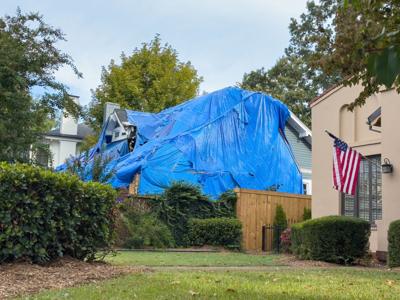The kaboom of a transformer blowing jolted Kevin and Hayden Kozak awake the morning of Sept. 27, 2024.
Hayden Kozak, who had fallen asleep on the couch with the family’s new pet cat Nacho, got to the kitchen the same time as her husband. Seeing the worsening storm outside, she rushed to wake the children, herding them downstairs and away from the windows.
It was not long after Kevin Kozak peeked out the french doors of their home in Greenville that a massive oak tree — more than 5 feet in diameter — came crashing through the roof less than 15 feet from where he stood.
Growing up in Pittsburgh, he’d never taken storms too seriously.
“I do now,” the 52-year-old Navy veteran and staffing agency executive told the SC Daily Gazette.
A high price
It’s been a year since Hurricane Helene swept across South Carolina and much of the Southeast, becoming one of the deadliest and costliest natural disasters in U.S. history.
Helene reached the Palmetto State as a tropical storm, with drenching rains and 75 mph winds that toppled trees and snapped power lines, leaving 49 people dead and 1.3 million homes and businesses in the dark. The storm spun off 21 tornadoes and caused significant destruction across 33 of South Carolina’s 46 counties, according to the state Emergency Management Division.
The storm damaged more than 5,000 homes, including that of the Kozaks.
A year later, their home remains under a tarp in disrepair. After much delay, their insurance company declared it a total loss and cleared it for demolition and rebuild. They’d been living there for less than a year when disaster struck.
“I just thank the Lord every day that we all made it out safe,” Kevin Kozak said. “You can rebuild a house, but you can’t bring back a life.”
In all, the storm killed at least 250 people along its entire path, according to the National Weather Service.
In South Carolina, the Federal Emergency Management Agency has since provided more than $323 million in assistance to individual uninsured and underinsured homeowners and renters in 28 counties and the Catawba Indian Nation.
The agency’s National Flood Insurance Program has paid policyholders over $9.72 million for flood losses, with more than 368 policyholders having filed claims.
Five of those claims remain open.
The U.S. Small Business Administration has approved more than $145 million in low-interest home and business damage loans.
And the state has mostly cleared an estimated 10 million cubic yards of storm debris. The state’s forestry agency estimates the total direct damage to the timber industry at $78.4 million, plus another $60 million worth of tree removal in the state’s more urban areas.
The U.S. Department of Agriculture on Tuesday announced $38.3 million in grant funding for South Carolina to help cover the timber losses.
“While the road to recovery is long, we have made measurable progress over the last year,” Kim Stenson, director of the South Carolina Emergency Management Division, said in a statement. “We know recovery doesn’t stop after the storm leaves. It’s a process, and we’ll continue working together until the job is done.”
A deluge of generosity
Luckily for the Kozaks, insurance paid to rent a home across town while they’ve waited for approvals, so they haven’t had to rely on federal aid to make ends meet.
Still, the back-and-forth with a litany of different insurance adjusters has been frustrating and the family of six is looking forward to the day they can return to a home with more space.
The kindness of their neighbors was unmatched, Kevin Kozak said. In the days without power following the storm, the neighborhood came together to cut trees off vehicles and hold cookouts to feed everyone.
“I think we’re closer now than ever before,” he said.
Along with the rain, the storm also brought in a deluge of generosity, marking the largest single activation of the state’s disaster charity fund.
The nonprofit One SC Fund, founded in response to catastrophic flooding in 2015, has raised nearly $6.2 million to help South Carolinians recover from Helene, said Georgia Mjartan, president and CEO of the Central Carolina Community Foundation, which operates the fund.
So far, the fund has made $4.15 million worth of grants to 65 nonprofits that have helped meet survivors’ basic needs and clean-up efforts. The remaining $2 million will go to long-term rebuilding and recovery, Mjartan said, and the fund is still open for donations.
It was a $25,000 grant that helped Cherokee County Meals on Wheels respond to demands never seen before in the organization’s four decades of operation.
“Funding during that time was critical; there were so many needs,” said Executive Director Terry Dennis.
‘People get discouraged’
For many of the people served by Meals on Wheels, wells were their only source of water. And without power, they couldn’t pump the water into their homes, Dennis said. The food pantry had to call in shelf-stable meals, something it usually doesn’t need until late October or November.
A year later, Meals on Wheels remains at some of its highest numbers on record as people are still feeling the financial burden caused by the storm, Dennis said. The group provides 20 meals to 20 homes daily, as well as extra groceries, toiletries and pet food.
“Our community also found that a lot of families weren’t properly insured, especially our older generation, and those that were in rental properties couldn’t go back,” Dennis said.
With a shortage of rent-controlled and handicap accessible housing in the rural county, Meals on Wheels had to help one woman in her late 60s move to nearby Spartanburg County when she couldn’t find a place that would take her and her two dogs.
The Meals on Wheels volunteers also have provided emotional support to people who, in the immediate aftermath, were alone, scared, without food and didn’t know what they were going to do. That support has continued as those same people grew frustrated while waiting for home repairs.
“When you’ve never had to live like that before, people get discouraged,” Dennis said.
There’s still unfinished clean up from downed trees on properties, where the elderly residents can’t afford to hire someone for the work they can’t do themselves.
Even in her own neighborhood, Dennis said a family just now got to pull the tarp off and put a new roof on.
“I don’t know how much time will go by before everyone’s back to normal,” she said.
In Pacolet, Gary and Patricia Brinkley have had to abandon their home of 33 years after FEMA thrice-denied the elderly couple’s claims and the insurance payout fell short of covering repairs. Town ordinances also wouldn’t allow the couple to place a new mobile home on the lot.
With nowhere else to go, the Brinkley’s son took out a loan to buy his parents another home, located about a mile from where a 90-foot oak tree came crashing through the roof of their former bedroom and living room.
The couple spent two months living with just a tarp and blankets for cover, sleeping in their car. Water seeped in and mold and mildew started to grow, making Patricia Brinkley sick.
The Brinkley’s homeowners’ insurance carrier declared their home in rural Spartanburg County a total loss.
The new home is nice. Built near the turn of the 20th century, it has hardwood floors and a big front porch.
Gary Brinkley wishes he would have received some form of aid. Living on Social Security, the couple has no way to pay their son back.
“Basically, we started over from scratch,” he said.
Years of work ahead
While many South Carolinians face rebuilding their homes, the cities, counties and utility companies also face their own challenges as they seek federal help paying for the massive cleanup efforts many have already undertaken.
The state has identified approximately 1,500 projects with a total cost of over $1.3 billion. So far, FEMA has doled out just $65 million.
It starts with a town, a county or a utility company proving their eligibility under a presidential disaster declaration, Emily Bentley, the state Emergency Management Division’s Chief of Recovery, told the SC Daily Gazette.
Then governments must separate the work into multiple projects — removing debris is separate from repairing a bridge.
And the entity has to be able to produce a mountain of paperwork for every step along the way. For small towns and utilities that don’t handle disasters on a regular basis, this creates a huge volume of work for a small number of people dragging out months and years. If FEMA rejects a town and it files an appeal, it can take even longer.
The city of Columbia, for example, waited nearly a decade after the 2015 floods for approval to repair the canal that is the source of the city’s drinking water.
That was a complex project that involved multiple environmental reviews and permits, Bentley said, but there are many other things that can snag up recovery work.
For debris, for example, governments have to show the volume of debris, where it picked up that debris, what type it was, where it stored the debris and where it disposed of it. Towns also must prove contractors did not overcharge for hauling it away.
If a town doesn’t apply for permits for a debris site or it takes debris to the wrong site, it’s enough to disqualify a project.
If debris is in a waterway, the town must prove it’s a risk to public health and safety to be reimbursed for removal.
For things like roads, towns have to prove that they’d been performing regular maintenance before the storm.
And if staff worked overtime, governments have to show the work they were doing and the equipment they used.
“So there’s a lot of a lot of little details like that that have to be reviewed and figured out,” Bentley said. “Those are the things that tend to slow stuff down.”
Large projects — anything that costs more than $1 million — must go through extra reviews at FEMA, which take 30 to 45 days. The federal disaster agency, this past spring, also added reviews for anything costing more $100,000, an additional step that is causing more delay, Bentley said.
“This is all taxpayer money, so you do want it to be spent appropriately,” she added. “But it does get a little frustrating sometimes for local entities that don’t have to deal with this on a regular basis.”
To help cover the cost, the state Legislature set aside $35 million in the budget for the state Department of Transportation to cover debris removal and road and bridge repairs not reimbursed by the federal government. The DOT has since reopened 99% of the more than 900 state roads closed due to Helene. The vast majority were reopened within weeks, according to the agency, which marked the progress last Friday with a ceremony at Jones Gap State Park.
The Legislature also provided nearly $200 million in state dollars to match federal funding for state agencies and local governments that couldn’t afford their share.
It also set aside $3 million for a new South Carolina Public Assistance program to help those cities and towns that don’t qualify for federal aid. The Emergency Management Division, which runs the program, says it will need more money for the fund in the next budget.
SC Daily Gazette is part of States Newsroom, a nonprofit news network supported by grants and a coalition of donors as a 501c(3) public charity. SC Daily Gazette maintains editorial independence. Contact Editor Seanna Adcox for questions: info@scdailygazette.com.













